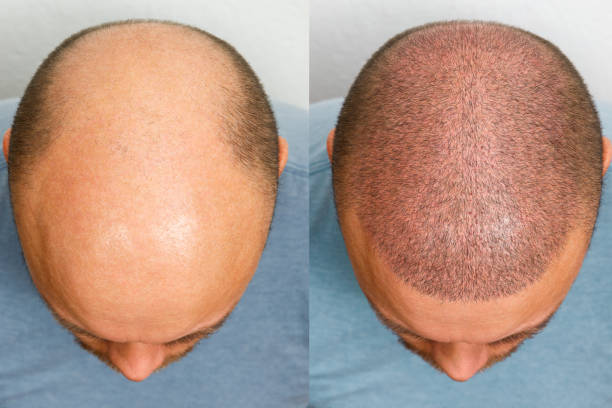What is hair transplantation?
Hair transplantation is a surgical procedure that involves moving hair follicles from one part of the body, called the “donor site”, to a bald or balding part of the body known as the “recipient site”. The technique is primarily used to treat male pattern baldness. During the procedure, a dermatologist or plastic surgeon removes hair follicles from the donor site, usually the back of the head, and transplants them to the recipient site. The hair follicles are usually transplanted in groups of one to four hairs, called “follicular units”. The transplanted hair will grow naturally and can be styled and cut just like your own hair.
Why do people have hair transplantation?
People may choose to undergo hair transplantation for a variety of reasons, including:
- To treat male pattern baldness or other forms of hair loss
- To improve the appearance of thinning hair or a receding hairline
- To restore hair to an area of the scalp that has been damaged or scarred
Hair transplantation can be an effective solution for people who are unhappy with the way their hair looks due to hair loss or thinning. The procedure can help to restore a natural-looking head of hair, which can improve self-esteem and confidence.
Who can have a hair transplant?

Hair transplantation can be performed on anyone who has hair loss or thinning hair. It is most performed on men, but it can also be done on women. The procedure is not recommended for people with certain medical conditions or who are taking certain medications. It is important to consult with a dermatologist or plastic surgeon to determine if hair transplantation is a suitable treatment option. They will be able to assess your overall health and the condition of your scalp to determine if you are a good candidate for the procedure.
Why is our hair falling out?
There are many potential causes of hair loss. Some common causes include:
- Genetics: Hair loss can be hereditary, meaning it runs in families. If you have a family history of hair loss, you may be more likely to experience it yourself.
- Age: Hair loss is more common as people get older.
- Hormonal changes: Changes in hormones, such as those that occur during menopause or pregnancy, can cause hair loss.
- Medical conditions: Certain medical conditions, such as anaemia, thyroid disease, and lupus, can cause hair loss.
- Medications: Some medications, such as those used to treat cancer or arthritis, can cause hair loss as a side effect.
- Physical or emotional stress: Experiencing physical or emotional stress can cause hair loss.
- Poor nutrition: Not getting enough nutrients or protein in your diet can lead to hair loss.
- Hairstyles and treatments: Tight ponytails, cornrows, and other hairstyles that pull on the hair can cause hair loss. Using heat or chemicals to style or treat the hair can also lead to hair loss.
It is important to speak with a healthcare provider if you are experiencing hair loss, as they can help determine the cause and recommend treatment options.
Will there be a natural appearance after hair transplantation?

When hair transplantation is performed in a full-fledged medical centre and by experts in the field, it is sure to achieve a natural and successful-looking result. Hair transplant design applications, especially under the control of plastic surgeons, are the guarantee of natural appearance. Since the results of hair transplant are permanent, it is very important to design the hair correctly. For a natural appearance, there should be no brush-like appearance after hair transplantation, the harmony of the direction of the hair follicles, and the correct hairline surrounding the face. The main goal of hair transplantation is to remove the abnormal appearance that occurs after hair loss. While trying to eliminate baldness, it is necessary to choose the right hair transplant centre and specialist in order not to encounter a worse appearance.
What are the best places for hair transplantation?
The best place for a hair transplantation procedure depends on the individual’s specific needs and goals. Some people may choose to have the procedure performed on the front of the scalp to restore a receding hairline, while others may choose to have it performed on the top of the scalp to improve the appearance of thinning hair.
In general, the best candidates for hair transplantation are people who have good overall health and realistic expectations about the results of the procedure. It is important to consult with a dermatologist or plastic surgeon who is experienced in performing hair transplantation to determine the best approach for your specific needs.
In situation the quality of care and results can vary widely. It is important to do your research and choose a reputable and experienced surgeon, regardless of where the procedure is performed. Some factors to consider when choosing a location for hair transplantation include:
- Cost: The cost of hair transplantation can vary significantly depending on the location.
- Quality of care: It is important to choose a surgeon who is experienced and has a track record of producing natural-looking results.
- Reputation: Look for a clinic with a good reputation and positive reviews from past patients.
- Comfort: Consider how comfortable you feel with the surgeon and their staff, as well as the overall environment of the clinic.
It is also a good idea to do some research on the local laws and regulations regarding medical procedures, as well as the overall safety and stability of the country.
What are the technics for hair transplantation?

There are several techniques that may be used for hair transplantation, including:
- Follicular Unit Transplantation (FUT): This technique involves removing a strip of skin from the donor site and dividing it into individual hair follicles, which are then transplanted to the recipient site.
- Follicular Unit Extraction (FUE): This technique involves extracting individual hair follicles from the donor site using a special punch tool. The follicles are then transplanted to the recipient site.
- Direct Hair Implantation (DHI): This technique is like FUE, but the hair follicles are transplanted directly to the recipient site using a special tool called a Choi implanter pen.
- Scalp Micropigmentation: This is a non-surgical technique that involves tattooing tiny dots of pigment onto the scalp to create the appearance of a fuller head of hair.
The best technique for a particular individual will depend on their specific needs and goals, as well as the availability of the techniques in their area. A dermatologist or plastic surgeon will be able to recommend the most appropriate technique for a given individual.
What is the best price range for hair transplantation?
The cost of hair transplantation can vary widely depending on several factors, including the technique used, the number of hair follicles transplanted, the complexity of the case, and the geographical location of the clinic. In general, the cost of the procedure can range from a few hundred dollars to tens of thousands of dollars.
It is important to keep in mind that hair transplantation is considered a cosmetic procedure, and it is not typically covered by health insurance. It is a good idea to research and compare prices from different clinics and to thoroughly understand the cost of the procedure before deciding.




0 Comments